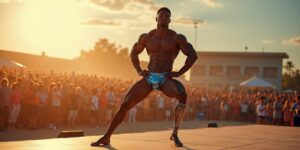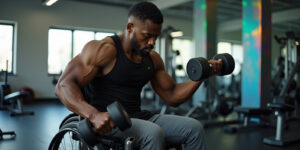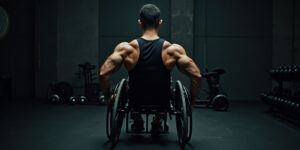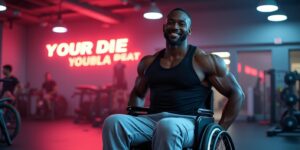When it comes to bodybuilding, the spotlight is often on the able-bodied athletes flexing their perfectly sculpted physiques under bright stage lights. But what about those whose strength is defined not only by their muscles but by their resilience, adaptability, and determination? If you’re someone living with a disability and are curious about diving into the world of bodybuilding competitions, let me tell you: this stage isn’t just for the able-bodied. It’s for you, too.
Bodybuilding for the disabled is growing rapidly, with competitions across the globe now embracing athletes with physical and intellectual disabilities. Ready to start your journey? Here’s a guide to help you flex your way into this empowering world.
Why Bodybuilding? What’s in It for You?
Bodybuilding isn’t just about aesthetics. It’s about challenging limits, building confidence, and showcasing what your body can do. For those with disabilities, bodybuilding goes beyond the physical transformation. It’s a platform for breaking stereotypes, inspiring others, and proving that strength isn’t bound by physical limitations.
Let’s face it, we all have a reason to train:
- To feel empowered.
- To push boundaries.
- To rewrite the narrative about what disabled athletes can achieve.
So, if you’ve been waiting for a sign, this is it. The stage is ready for you.
Research and Find Your Starting Point
The first step is understanding what’s out there. Did you know there are specific bodybuilding categories for athletes with disabilities? Competitions like the NPC Wheelchair Nationals, the Arnold Classic Pro Wheelchair, and various regional disabled athlete events are tailored to celebrate YOUR abilities.
Start by exploring these:
- Wheelchair Bodybuilding: Perfect if you use a wheelchair and want to showcase upper body strength.
- Adaptive Bodybuilding: Designed for those with limb differences, cerebral palsy, or other physical impairments.
- Intellectual Disability Categories: If cognitive challenges are part of your journey, some events cater specifically to you.
Each competition has its own rules, classifications, and judging criteria. Take your time to learn about them so you can find the category that feels like the perfect fit.
Start with Training Tailored to You
Bodybuilding isn’t a one-size-fits-all journey—especially for disabled athletes. It’s about adaptation. Whether you’re training for strength, endurance, or aesthetics, your workout plan should cater to your specific needs.
Here’s how to start:
Assess Your Strengths and Challenges
- Are you focusing on upper body strength because of limited leg mobility?
- Do you need a coach familiar with adaptive equipment or techniques?
Choose the Right Equipment
Many gyms now offer adaptive fitness equipment, like resistance bands, modified weight machines, and accessible benches. If your gym doesn’t have these, consider investing in your own gear.
Prioritize Form Over Weight
Proper form is crucial for everyone, but it’s even more important when you’re adapting movements to your body. Work with a trainer who understands your needs and can guide you on techniques that are safe and effective.
Progression Is Key
Start slow. Building strength takes time, and injury prevention should always be your top priority.
Nutrition: Fueling Your Body, Your Way
When it comes to bodybuilding, diet is as important as training—if not more. But disabilities can sometimes bring unique dietary challenges. Whether it’s managing energy levels, dealing with specific medical conditions, or just finding a routine that works, nutrition plays a big role.
Basics of a Bodybuilder’s Diet
- Protein: Aim for lean sources like chicken, fish, eggs, or plant-based options if you’re vegetarian.
- Carbs: Fuel your workouts with complex carbs like oats, brown rice, or sweet potatoes.
- Fats: Don’t shy away from healthy fats like avocado, nuts, and olive oil.
- Supplements: Protein powders, BCAAs, and creatine can be your friends—but consult your doctor or dietitian first.
Adaptive Nutrition Tips
- If your mobility is limited, monitor caloric intake to avoid excess weight gain.
- Stay hydrated—especially if you’re prone to overheating or have reduced sweating capacity.
Work with a nutritionist experienced in adaptive bodybuilding. They’ll help craft a plan that works for you.
Join the Community and Find Support
Bodybuilding may feel like a solo journey when you’re hitting the gym at 6 a.m., but the truth is, it’s a community-driven sport. For disabled athletes, this community can be a game-changer.
Find a Mentor or Coach
- Look for coaches who specialize in adaptive bodybuilding or have worked with disabled athletes.
- Join online forums, social media groups, or local organizations where adaptive athletes share tips and experiences.
Surround Yourself with Positivity
Some days will be tougher than others. Maybe it’s a training plateau, or maybe it’s the mental hurdle of feeling “different.” Having a support network—be it family, friends, or fellow athletes—will help you push through those moments.
Prepare for Your First Competition
Stepping on stage for the first time can be nerve-wracking—but it’s also one of the most rewarding experiences you’ll ever have.
Understand the Rules
Every competition has its own guidelines. Familiarize yourself with the posing requirements, judging criteria, and any accommodations available for disabled athletes.
Practice Posing
Posing isn’t just about flexing your muscles—it’s about showing off your hard work in the best light. Spend time perfecting your poses with a coach who understands your abilities and limitations.
Choose Your Gear
From custom wheelchairs for wheelchair bodybuilding to adaptive posing trunks, make sure you’ve got the right equipment to shine on stage.
Get Your Mind Right
Mental preparation is just as important as physical readiness. Visualization, meditation, or even just daily affirmations can help you stay focused and confident.
Embrace the Journey, Not Just the Destination
Bodybuilding for the disabled isn’t just about competition—it’s about discovering your potential. Along the way, you’ll inspire others, change perceptions, and most importantly, prove to yourself just how strong you are.
Don’t rush the process. Celebrate every milestone, whether it’s lifting a heavier weight, sticking to your diet, or simply feeling more confident in your own skin.
Challenges to Expect—and How to Overcome Them
Let’s be real: the journey isn’t always smooth. From lack of accessibility in gyms to the occasional naysayer who doubts your capabilities, challenges are inevitable. But here’s the thing—you’ve already overcome so much in life. These hurdles? They’re just stepping stones.
Tips to Push Through
- Advocate for accessibility in your gym or community.
- Educate others about adaptive bodybuilding.
- Use every “no” you hear as fuel to prove people wrong.
Resources for Adaptive Bodybuilding
Here are some resources to help you along the way:
- Organizations: International Federation of Bodybuilding & Fitness (IFBB) and World Para Powerlifting.
- Adaptive Fitness Apps: Apps like WheelWOD or Adaptive Training Academy can guide your workouts.
- Social Media: Follow athletes like Nick Scott or Reggie Bennett for inspiration.
Final Word: Step into Your Strength
Bodybuilding competitions for the disabled aren’t just about winning trophies. They’re about showing the world—and yourself—that limits are meant to be broken.
Whether you’re just starting or already on your way, remember this: every drop of sweat, every rep, and every pose is a testament to your strength. So gear up, hit the gym, and let’s see what you’re made of.
The stage is waiting for you. Are you ready?




